Elisabeth Nyirakaragire, the Gorilla Doctors’ Most Dedicated Assistant
By Gorilla Doctors Staff on Wednesday, May 23rd, 2012 in Uncategorized.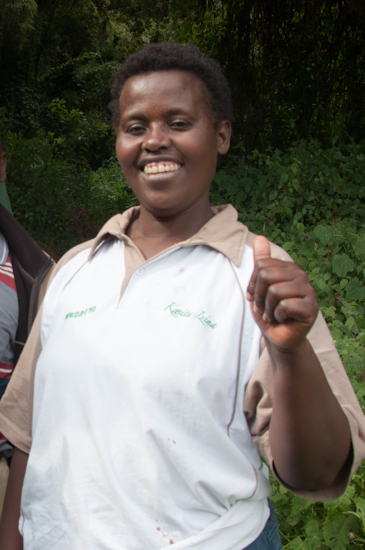 Elisabeth Nyirakaragire gives a thumbs up after a successful intervention in Volcanoes National Park, Rwanda.By Dr. Dawn
Elisabeth Nyirakaragire gives a thumbs up after a successful intervention in Volcanoes National Park, Rwanda.By Dr. Dawn
“They looked like old men,” says Elisabeth Nyirakaragire, the veterinary assistant for Volcanoes National Park in Rwanda, as we trek up the volcano to check on the newly formed mountain gorilla group, Karisimbi B. She recalls her first impression of mountain gorillas when she saw them at 19 years of age on a school trip during her last year of secondary school. “Their faces looked like old men.” She chuckles a bit at the memory of her amazement, the revelation of how similar gorillas look to humans. Having grown up in Kinigi, where the Volcanoes National Park headquarters is located, she had never even considered working with wildlife until she saw her first gorilla. She was surprised by their friendly behavior, and immediately became interested in getting a conservation job to help ensure the mountain gorillas’ survival.
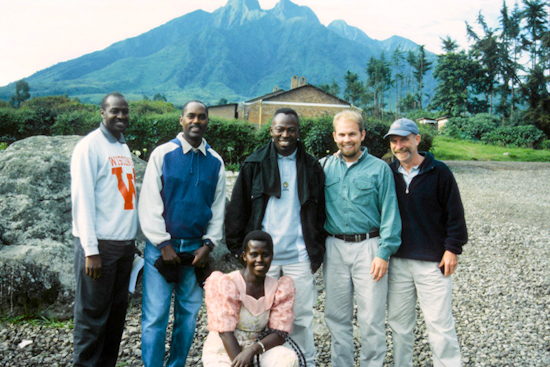 Elisabeth and the Gorilla Doctors’ team in 2003.Just a few months later, she graduated from secondary school and was hired by the Rwanda Office for Tourism and National Parks (now part of the Rwandan Development Board) as a veterinary assistant, working alongside the very first Gorilla Doctor, Dr. James Foster. Dr. Foster taught her about gorilla diseases and behavior, and how the manifestation and exhibition of illness differs between wild and domestic animals. From 1991 to 1993, Elisabeth studied to become a wildlife management specialist at the Ecole de Specialist de la Faune in Cameroon. She learned about wildlife management and animal diseases, including immobilization and darting techniques.
Elisabeth and the Gorilla Doctors’ team in 2003.Just a few months later, she graduated from secondary school and was hired by the Rwanda Office for Tourism and National Parks (now part of the Rwandan Development Board) as a veterinary assistant, working alongside the very first Gorilla Doctor, Dr. James Foster. Dr. Foster taught her about gorilla diseases and behavior, and how the manifestation and exhibition of illness differs between wild and domestic animals. From 1991 to 1993, Elisabeth studied to become a wildlife management specialist at the Ecole de Specialist de la Faune in Cameroon. She learned about wildlife management and animal diseases, including immobilization and darting techniques.
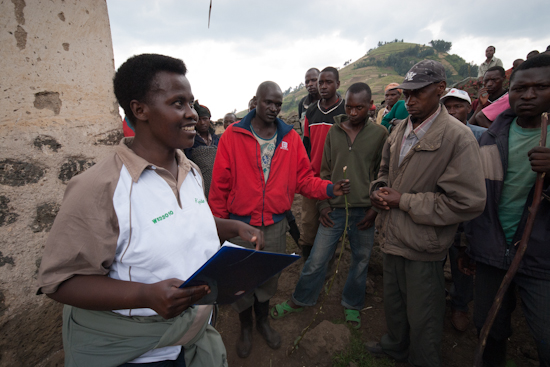 Elisabeth speaks with community members outside of Volcanoes National Park.As the first and only veterinary assistant for Volcanoes National Park over the last 25 years, Elisabeth has been responsible for monitoring the health of the Park’s wildlife, mainly the critically endangered mountain gorillas but also the endangered golden monkeys and forest buffalo. She works closely with the Gorilla Doctors, playing an integral role in assisting with interventions and necropsies, and often the first person to respond to reports of illness or injury. One of the most important aspects of her job is teaching the trackers how to monitor the gorillas’ health on a daily basis, as the trackers take on the substantial and consequential task of reporting any changes in health or behavior of the animals.
Elisabeth speaks with community members outside of Volcanoes National Park.As the first and only veterinary assistant for Volcanoes National Park over the last 25 years, Elisabeth has been responsible for monitoring the health of the Park’s wildlife, mainly the critically endangered mountain gorillas but also the endangered golden monkeys and forest buffalo. She works closely with the Gorilla Doctors, playing an integral role in assisting with interventions and necropsies, and often the first person to respond to reports of illness or injury. One of the most important aspects of her job is teaching the trackers how to monitor the gorillas’ health on a daily basis, as the trackers take on the substantial and consequential task of reporting any changes in health or behavior of the animals.
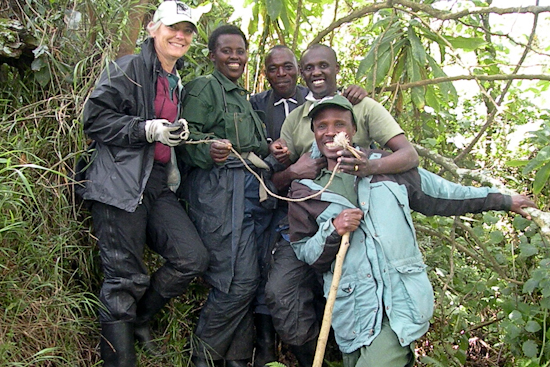 Elisabeth with Drs. Jan and Jean-Felix and Volcanoes National Park Ranger Damascene Hakizimana after successfully removing a snare from an infant.When Elisabeth began her tenure in 1987, the mountain gorilla population of the Virunga Massif was estimated to include only 240 individuals, with 4 habituated tourist groups. Today, there are an estimated 480 gorillas in the Virunga Massif with 10 habituated tourist groups. This population increase is particularly significant in that mountain gorillas are the only great ape species increasing in number. Elisabeth takes pride in the fact that she not only contributed to the survival of mountain gorillas, but to the growth of this critically endangered species.
Elisabeth with Drs. Jan and Jean-Felix and Volcanoes National Park Ranger Damascene Hakizimana after successfully removing a snare from an infant.When Elisabeth began her tenure in 1987, the mountain gorilla population of the Virunga Massif was estimated to include only 240 individuals, with 4 habituated tourist groups. Today, there are an estimated 480 gorillas in the Virunga Massif with 10 habituated tourist groups. This population increase is particularly significant in that mountain gorillas are the only great ape species increasing in number. Elisabeth takes pride in the fact that she not only contributed to the survival of mountain gorillas, but to the growth of this critically endangered species.
As we trek further up the mountain in the cold rain, Elisabeth stops to adjust her knee brace. Two years ago, she was in a motorcycle taxi accident that tore all the ligaments in her left knee. She was in a cast for months but when it came off she started right back up the mountains to monitor the park’s gorillas. I continue to marvel at her experiences, from narrowly escaping a buffalo attack to persevering through the genocide and civil unrest of the 1990s when much of the park staff worked without pay to monitor and protect the mountain gorillas.
The two words she continues to use in describing the gorillas are friendly but protective, and she is both perplexed and awed by their ability to communicate. Once, she witnessed an infant running into the group, vocalizing to the silverback. The silverback responded by pushing the group together for safety, then followed the infant out of the group to find a lone silverback, a threat to the group.
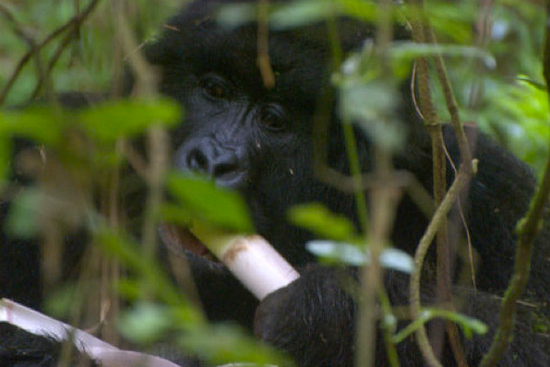 Female Icyuzuzo of Agashya group.In 2006, she recalls an aggressive interaction between two adult females in Agashya group resulting in a severe bite wound to an infant, causing the loss of three fingers. Elisabeth and the Gorilla Doctors planned for an intervention. Because it was an infant and carried by mom Isoni, the mother had to be anesthetized in order to assess and treat the baby. However, once Isoni was darted and became recumbent, another adult female in the group, Icyuzuzo, ran over and grabbed the baby, thinking it was in danger because the mother had died. The group then became aggressive toward the veterinary staff and the intervention had to be called off. Although an unfortunate situation, this relays just how protective the members of the group are in caring for each other.
Female Icyuzuzo of Agashya group.In 2006, she recalls an aggressive interaction between two adult females in Agashya group resulting in a severe bite wound to an infant, causing the loss of three fingers. Elisabeth and the Gorilla Doctors planned for an intervention. Because it was an infant and carried by mom Isoni, the mother had to be anesthetized in order to assess and treat the baby. However, once Isoni was darted and became recumbent, another adult female in the group, Icyuzuzo, ran over and grabbed the baby, thinking it was in danger because the mother had died. The group then became aggressive toward the veterinary staff and the intervention had to be called off. Although an unfortunate situation, this relays just how protective the members of the group are in caring for each other.
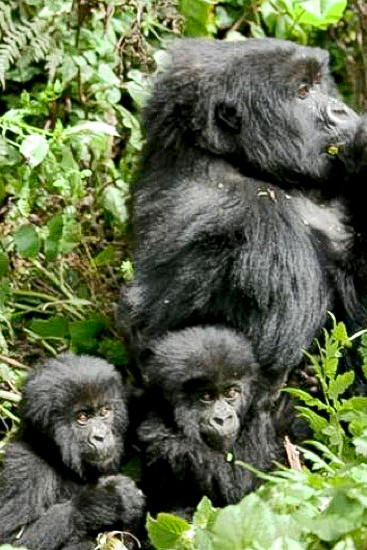 Female Nyabitondore and her twins in 2005.In another incident in 2005 she recalls a female in Susa group, Nyabitondore, giving birth to twins, Ibyishimo and Impano. At two days old, the twins were a handful and Nyabitondore was unable to move about the forest enough to feed normally. Elisabeth watched as a blackback in the group gathered food to bring to the female throughout the day.
Female Nyabitondore and her twins in 2005.In another incident in 2005 she recalls a female in Susa group, Nyabitondore, giving birth to twins, Ibyishimo and Impano. At two days old, the twins were a handful and Nyabitondore was unable to move about the forest enough to feed normally. Elisabeth watched as a blackback in the group gathered food to bring to the female throughout the day.
Elisabeth wonders if there is not something we can learn from the gorillas’ behavior, as it applies to treating our fellow human beings.
When we arrive at the new Karisimbi B group, all seven gorillas are huddled in the brush, trying to keep warm in the cold rain. We find the silverback Getty, blackback Muturengere, Ruhuka and her infant, Poppy and her infant Ejoheza, and the surprise addition of Isura, a juvenile female from Pablo group. This split of groups is considered a progression of the population and we hope that Karisimbi B will grow into a larger group with the addition of more infants over the years.
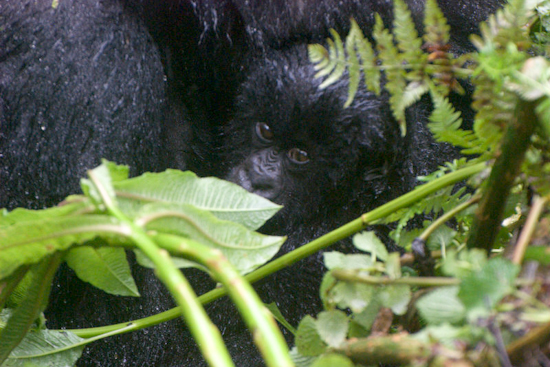 Female Ruhuka and infant of Karisimbi B group.We observe all of the gorillas, especially the two infants, to check for any signs of health problems. This is one of Elisabeth’s favorite tasks—watching all the infants and juveniles, seeing them thrive and grow over the years, from infants weighing a mere 2 kilos to 200-kilo dominant silverbacks. When I ask her if she has a favorite group or gorilla, she gives me her big, trademark smile and says, “No, I love them all.”
Female Ruhuka and infant of Karisimbi B group.We observe all of the gorillas, especially the two infants, to check for any signs of health problems. This is one of Elisabeth’s favorite tasks—watching all the infants and juveniles, seeing them thrive and grow over the years, from infants weighing a mere 2 kilos to 200-kilo dominant silverbacks. When I ask her if she has a favorite group or gorilla, she gives me her big, trademark smile and says, “No, I love them all.”
You can follow the Gorilla Doctors health monitoring efforts on our Facebook page, where we post photos and notes from our monthly visits.
Please consider supporting MGVP by making a secure online donation. Every dollar you give goes to directly supporting our gorilla health programs and One Health initiative. Thank you for your generosity.


 Donate
Donate